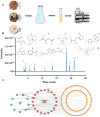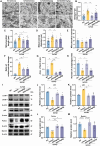Sanshen San Formula Hinders Cognitive Function and Pathology in Alzheimer's Disease Through Potentiating the Function of Synapse
- PMID: 40202070
- PMCID: PMC11979623
- DOI: 10.1111/cns.70349
Sanshen San Formula Hinders Cognitive Function and Pathology in Alzheimer's Disease Through Potentiating the Function of Synapse
Abstract
Background: Alzheimer's disease (AD) constitutes a devastating neurodegenerative disorder, manifested by amyloid-β aggregation, phosphorylated tau accumulation, and progressive cognitive deterioration. Current therapeutic interventions remain predominantly symptomatic, underscoring the urgency for more efficacious treatment strategies.
Purpose: This study elucidated the therapeutic potential of Sanshen San (SSS), a traditional Chinese herbal formula encompassing Polygala Radix, Pini Radix in Poria, and Acori Tatarinowii Rhizoma, on cognitive function and AD pathology.
Methods: We implemented both acute Aβ1-42-injected mice and 5xFAD transgenic mouse models. The therapeutic efficacy of SSS was assessed through behavioral paradigms including Y-maze, Novel Object Recognition, and Morris Water Maze. Molecular mechanisms were delineated utilizing RNA sequencing, metabolomics analysis, immunofluorescence staining, Golgi-Cox staining, transmission electron microscopy, and Western blotting.
Results: Chemical analysis unveiled 10 principal bioactive compounds in SSS. The formula substantially ameliorated cognitive performance in both Aβ1-42-injected and 5xFAD mouse models, attenuated Aβ plaque burden, and augmented microglial phagocytosis. SSS safeguarded synaptic integrity, enhanced mitochondrial function, and facilitated autophagy. Transcriptomic and metabolomic analyses demonstrated that SSS predominantly operates by reinstating synaptic transmission and neurotransmitter function, particularly in the dopaminergic system.
Conclusion: SSS efficaciously mitigates AD pathology through potentiating synaptic function, optimizing mitochondrial homeostasis, and restoring neurotransmitter balance, exemplifying a promising multi-target therapeutic strategy for the treatment of AD.
Keywords: Alzheimer's disease; Sanshen san formula; Traditional Chinese medicine; autophagy; neuron.
© 2025 The Author(s). CNS Neuroscience & Therapeutics published by John Wiley & Sons Ltd.
Conflict of interest statement
The authors declare no conflicts of interest.
Figures






Similar articles
-
Acori Tatarinowii Rhizoma regulates OCT3/OATP2 and P-gp/MRP1 to "guide medicines upwards" in Kai-Xin-San to treat Alzheimer's disease.J Ethnopharmacol. 2025 Mar 13;343:119484. doi: 10.1016/j.jep.2025.119484. Epub 2025 Feb 11. J Ethnopharmacol. 2025. PMID: 39947370
-
Kaixinsan regulates neuronal mitochondrial homeostasis to improve the cognitive function of Alzheimer's disease by activating CaMKKβ-AMPK-PGC-1α signaling axis.Phytomedicine. 2024 Dec;135:156170. doi: 10.1016/j.phymed.2024.156170. Epub 2024 Oct 28. Phytomedicine. 2024. PMID: 39520951
-
The dopamine analogue CA140 alleviates AD pathology, neuroinflammation, and rescues synaptic/cognitive functions by modulating DRD1 signaling or directly binding to Abeta.J Neuroinflammation. 2024 Aug 11;21(1):200. doi: 10.1186/s12974-024-03180-x. J Neuroinflammation. 2024. PMID: 39129007 Free PMC article.
-
Exploring Dimethylsulfoniopropionate as a potential treatment for Alzheimer's disease: A study using the 3 × Tg-AD mouse model.Phytomedicine. 2024 Jul 25;130:155788. doi: 10.1016/j.phymed.2024.155788. Epub 2024 May 28. Phytomedicine. 2024. PMID: 38838634
-
Rg1 improves Alzheimer's disease by regulating mitochondrial dynamics mediated by the AMPK/Drp1 signaling pathway.J Ethnopharmacol. 2025 Jan 31;340:119285. doi: 10.1016/j.jep.2024.119285. Epub 2024 Dec 27. J Ethnopharmacol. 2025. PMID: 39733799
References
-
- Association, A. S , “Alzheimer's Disease Facts and Figures,” Alzheimer's & Dementia 15, no. 3 (2019): 321–387.
-
- Liu Q., Contreras A., Afaq M. S., et al., “Intensity‐Dependent Gamma Electrical Stimulation Regulates Microglial Activation, Reduces Beta‐Amyloid Load, and Facilitates Memory in a Mouse Model of Alzheimer's Disease,” Cell & Bioscience 13, no. 1 (2023): 138, 10.1186/s13578-023-01085-5. - DOI - PMC - PubMed
MeSH terms
Substances
Grants and funding
LinkOut - more resources
Full Text Sources
Medical

